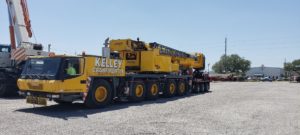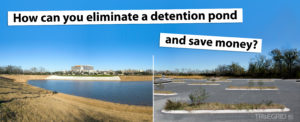All commercial sites need to consider stormwater management when being designed and developed. The traditional way to design for stormwater management is take a big chunk of land on a new site and use it to build a detention pond. The pond is designed to have capacity to detain the runoff from the entire piece of land including impervious buildings or paving. All stormwater runoff is directed to the detention pond in the event of rain to compensate for the developed impervious surfaces, runoff from buildings and pavement.
Detention ponds are expensive to build and to maintain. Base capital costs including engineering and design, geotechnical testing, drainage elements including piping and pumps, filters, excavation and soil removal, concrete work, legal fees, landscaping and architectural elements add up to expensive construction for a hole in the ground. Additionally, detention ponds require long term maintenance to operate properly. Unmaintained ponds become a source of mosquito breeding grounds and toxics in the groundwater as well as aesthetic blights.
Perhaps the greatest cost of detention ponds is the land. The value of land is often the most important consideration to a developer. Land used for a detention pond cannot be used for generating revenue – a larger building (s), more parking, green space. This makes the cost per square foot of a project escalate as the land utilization is reduced dramatically when a detention pond is factored in. Sometimes detention requirements can eat up as much as 25 to 30% of a site. This cost affects not only the upfront capital expense for construction and maintenance cost of the property but also the cost or price of the facility in use.

As an example, if a large equipment rental facility can park 40 mobile cranes, trucks or tractors on their yard that they can rent at $20,000 /month, they can generate $800,000 / month in revenue. If 25% of the site is used for a detention pond, they can only park 30 cranes and generate $600,000/month in revenue. That’s a lost opportunity cost of $200,000 per month or $2.4 million per year.
Is the only alternative to raise prices to make up for that shortfall and hope to not lose out to competition?
No. There is an alternative that costs the least upfront to construct, the least to maintain, and offers maximum land utilization for revenue. By paving with TRUEGRID permeable pavers instead of concrete or asphalt the economics of a site can be altered in a dramatically positive way. The TRUEGRID pavement system is 100% pervious and has storm water detention capacity under the grid surface in the base rock. On the first point of pervious cover, TRUEGRID does not count against a site’s impervious surface because the permeable pavement system drains at over 800 inches per hour and is permitted as 100% pervious. All things being equal, a site with a building and hardscape concrete or asphalt paving will have a much greater percentage of impervious surface than a site with permeable TRUEGRID and a building. What does that mean to the owner/ developer? Well, they can now have a bigger building if they so choose.
On the second point of stormwater detention, the required capacity of cubic feet of stormwater detention on the site can be stored under the TRUEGRID paving surface in the 40% void space in the base rock. That means the parking area has not become a giant detention pond that you can drive/park/walk/ work/recreate on. Most times, a separate detention pond is not needed. With TRUEGRID, drive on the surface, drain and detain stormwater below. The cost of an installed TRUEGRID lot is generally 20% less than a concrete lot. Add the savings of not having to build a separate detention pond, no ongoing maintenance and the land savings and utilization- and you’ve got an easy way to eliminate a site’s detention pond while developing responsibly for stormwater management and saving a bundle in the process.
SUCCESS STORY: World’s Largest Permeable Paver Parking Lot
Large 4 Acre Detention Pond Eliminated. (Watch video below)
DRIVE ON THE SURFACE AND DETAIN STORMWATER BELOW IN THE ROCK SUB-BASE.
P ut your storm water detention under the parking lot. With TRUEGRID plastic grid pavers filled with gravel on a rock sub-base, rain drains virtually instantly- over 800 inches per hour. The surface is 100 % pervious and the crossection of the sub-base rock and rock filled, TRUEGRID can detain stormwater.
ut your storm water detention under the parking lot. With TRUEGRID plastic grid pavers filled with gravel on a rock sub-base, rain drains virtually instantly- over 800 inches per hour. The surface is 100 % pervious and the crossection of the sub-base rock and rock filled, TRUEGRID can detain stormwater.
Eliminate your detention pond and save money?
Build with TRUEGRID® to eliminate detention ponds and utilize 100% of your land for more parking, storage units, and revenue. Expand an existing parking lot without adding new detention.
100% Permeable + Increased Land Use = MORE REVENUE
Benefits.
- Flood Protection
- Cities appreciate Low Impact Development
- Lower Construction Costs
- Upgrade existing lots – eliminate dust & mud
- Eco-Friendly Marketing Opportunities
- Fast & Easy to Install





